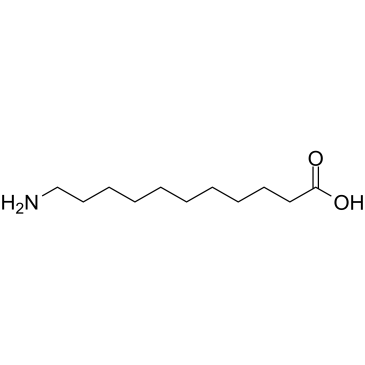11-Aminoundecanoic acid

11-Aminoundecanoic acid structure
|
Common Name | 11-Aminoundecanoic acid | ||
|---|---|---|---|---|
| CAS Number | 2432-99-7 | Molecular Weight | 201.306 | |
| Density | 1.0±0.1 g/cm3 | Boiling Point | 334.9±15.0 °C at 760 mmHg | |
| Molecular Formula | C11H23NO2 | Melting Point | 188-191 °C(lit.) | |
| MSDS | Chinese USA | Flash Point | 156.3±20.4 °C | |
|
Advanced material and approach for metal ions removal from aqueous solutions.
Sci. Rep. 5 , 8992, (2015) A Novel approach to remove metals from aqueous solutions has been developed. The method is based on a resin free, solid, non-toxic, microcrystalline bisphosphonate material, which has very low solubility in water (59 mg/l to ion free Milli-Q water and 13 mg/l... |
|
|
Development of 68Ga-labeled fatty acids for their potential use in cardiac metabolic imaging.
J. Labelled Comp. Radiopharm. 57(7) , 463-9, (2014) While [(11)C]palmitate continues to be a promising tracer for cardiovascular Positron Emission Tomography (PET) imaging, unfavourable logistics due to the short half-life of (11)C (20 min) and cumbersome labeling methodologies are the major impediments that l... |
|
|
Biocompatibility of Fe(3)O(4) nanoparticles evaluated by in vitro cytotoxicity assays using normal, glia and breast cancer cells.
Nanotechnology 21 , 75102, (2010) In order to reveal the biocompatibility of Fe(3)O(4) nanoparticles and bipolar surfactant tetramethylammonium 11-aminoundecanoate cytotoxicity tests were performed as a function of concentration from low (0.1 microg ml(-1)) to higher concentration (100 microg... |
|
|
11-Aminoundecanoic acid.
IARC Monogr. Eval. Carcinog. Risk Chem. Hum. 39 , 239-45, (1986)
|
|
|
Tailoring aqueous solubility of functionalized single-wall carbon nanotubes over a wide pH range through substituent chain length.
Nano Lett. 5(10) , 2001-4, (2005) Carboxylic acid-functionalized SWNTs prepared via the reaction of an amino acid, NH2(CH2)nCO2H, with fluoronanotubes show similar levels of sidewall functionalization; however, the solubility in water is controlled by the length of the hydrocarbon side chain ... |
|
|
Hydrolytic degradation study of biodegradable polyesteramide copolymers based on epsilon-caprolactone and 11-aminoundecanoic acid.
Biomaterials 25(11) , 1975-81, (2004) In this paper, a new kind of aliphatic biodegradable polyesteramide copolymers P(CL/AU)x/y based on epsilon-caprolactone and 11-aminoundecanoic acid were synthesized by the melt polycondensation method. Hydrolytic degradation behavior of P(CL/AU) copolymers w... |
|
|
Transformation of BALB/c-3T3 cells: III. Development of a co-culture clonal survival assay for quantification of chemical cytotoxicity in high-density cell cultures.
Environ. Health Perspect. 101 Suppl 2 , 311-8, (1993) A co-culture clonal survival assay was developed to measure the cytotoxicity of test chemical treatments to BALB/c-3T3 cells because the standard clonal survival assay using 200 wild type (WT) cells frequently overestimates chemical cytotoxicity when compared... |
|
|
A quantitative study of the biospecific desorption of rat liver (M4) lactate dehydrogenase from 10-carboxydecylamino-Sepharose. Determination of the number of ligand-binding sites blocked on adsorption.
Biochem. J. 207(3) , 549-56, (1982) 1. The theory of Nichol, Ogston, Winzor & Sawyer [(1974) Biochem. J. 143, 435-443] for quantitative affinity chromatography, when adapted for use with a non-specific column from which a multi-site protein can be specifically desorbed by its free ligand, permi... |
|
|
Lesions of the urinary tract produced in Fischer 344 rats and B6C3F1 mice after chronic administration of 11-aminoundecanoic acid.
Fundam. Appl. Toxicol. 3(6) , 614-8, (1983) 11-Aminoundecanoic acid, the monomer of nylon 11, was toxic to the urinary tract of both male and female B6C3F1 mice and Fischer 344 rats, when administered in the diet at 7500 or 15 000 ppm for 103-104 weeks. Dose-related effects included a decrease in mean ... |
|
|
DNA binding assay with 11-aminoundecanoic acid-[11-14C] in F-344 rats.
Arch. Toxicol. 61(1) , 86-7, (1987)
|